Nursing Leadership in Healthcare Settings
VerifiedAdded on 2020/03/04
|10
|2570
|48
AI Summary
This assignment delves into the crucial role of nursing leadership in fostering quality and safety within healthcare settings. It examines various aspects of effective clinical leadership, including its impact on patient outcomes, barriers to development, and strategies for improvement. The assignment also emphasizes the importance of continuous quality improvement (CQI) and the National Safety and Quality Health Service Standards (NSQHS) in upholding high standards of care.
Contribute Materials
Your contribution can guide someone’s learning journey. Share your
documents today.
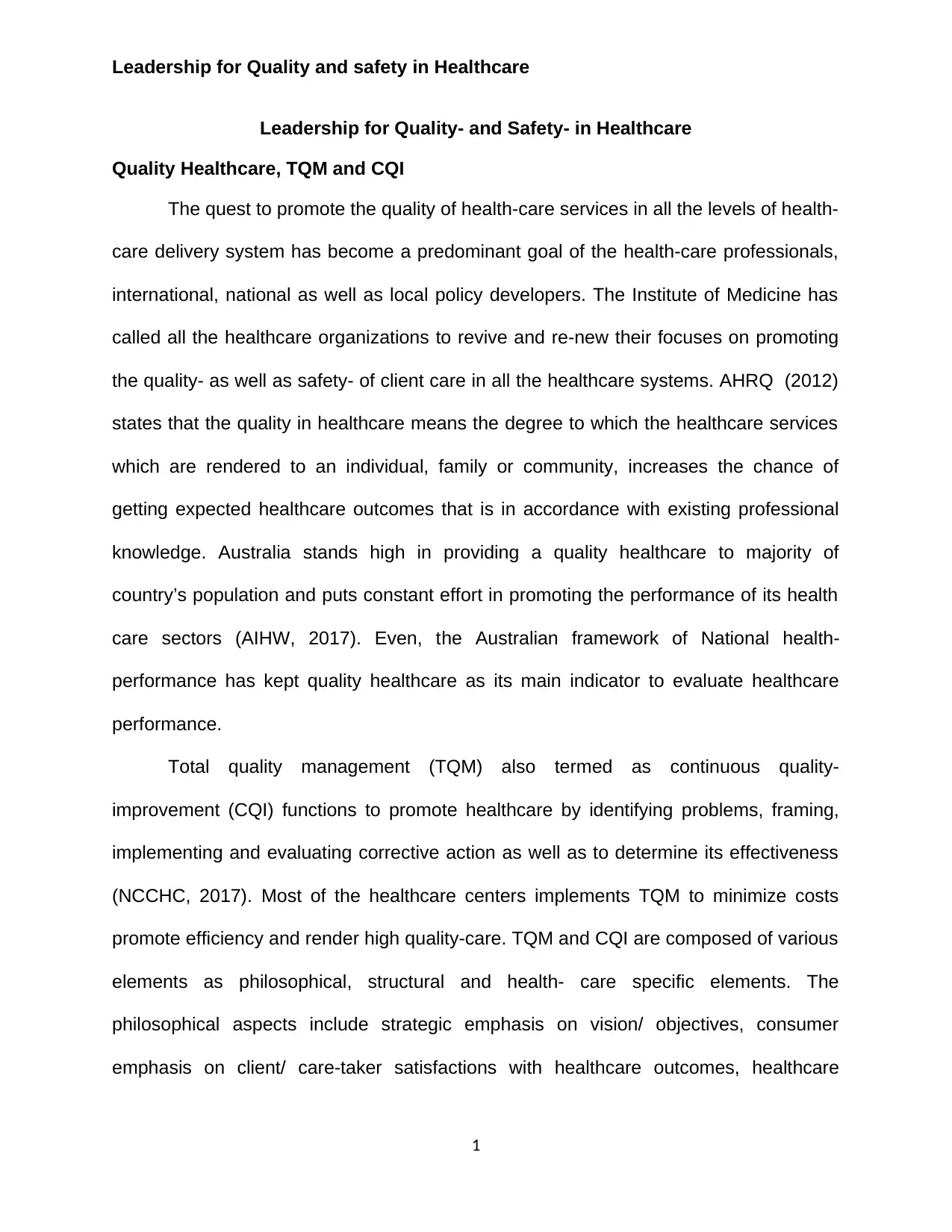
Leadership for Quality and safety in Healthcare
Leadership for Quality- and Safety- in Healthcare
Quality Healthcare, TQM and CQI
The quest to promote the quality of health-care services in all the levels of health-
care delivery system has become a predominant goal of the health-care professionals,
international, national as well as local policy developers. The Institute of Medicine has
called all the healthcare organizations to revive and re-new their focuses on promoting
the quality- as well as safety- of client care in all the healthcare systems. AHRQ (2012)
states that the quality in healthcare means the degree to which the healthcare services
which are rendered to an individual, family or community, increases the chance of
getting expected healthcare outcomes that is in accordance with existing professional
knowledge. Australia stands high in providing a quality healthcare to majority of
country’s population and puts constant effort in promoting the performance of its health
care sectors (AIHW, 2017). Even, the Australian framework of National health-
performance has kept quality healthcare as its main indicator to evaluate healthcare
performance.
Total quality management (TQM) also termed as continuous quality-
improvement (CQI) functions to promote healthcare by identifying problems, framing,
implementing and evaluating corrective action as well as to determine its effectiveness
(NCCHC, 2017). Most of the healthcare centers implements TQM to minimize costs
promote efficiency and render high quality-care. TQM and CQI are composed of various
elements as philosophical, structural and health- care specific elements. The
philosophical aspects include strategic emphasis on vision/ objectives, consumer
emphasis on client/ care-taker satisfactions with healthcare outcomes, healthcare
1
Leadership for Quality- and Safety- in Healthcare
Quality Healthcare, TQM and CQI
The quest to promote the quality of health-care services in all the levels of health-
care delivery system has become a predominant goal of the health-care professionals,
international, national as well as local policy developers. The Institute of Medicine has
called all the healthcare organizations to revive and re-new their focuses on promoting
the quality- as well as safety- of client care in all the healthcare systems. AHRQ (2012)
states that the quality in healthcare means the degree to which the healthcare services
which are rendered to an individual, family or community, increases the chance of
getting expected healthcare outcomes that is in accordance with existing professional
knowledge. Australia stands high in providing a quality healthcare to majority of
country’s population and puts constant effort in promoting the performance of its health
care sectors (AIHW, 2017). Even, the Australian framework of National health-
performance has kept quality healthcare as its main indicator to evaluate healthcare
performance.
Total quality management (TQM) also termed as continuous quality-
improvement (CQI) functions to promote healthcare by identifying problems, framing,
implementing and evaluating corrective action as well as to determine its effectiveness
(NCCHC, 2017). Most of the healthcare centers implements TQM to minimize costs
promote efficiency and render high quality-care. TQM and CQI are composed of various
elements as philosophical, structural and health- care specific elements. The
philosophical aspects include strategic emphasis on vision/ objectives, consumer
emphasis on client/ care-taker satisfactions with healthcare outcomes, healthcare
1
Secure Best Marks with AI Grader
Need help grading? Try our AI Grader for instant feedback on your assignments.
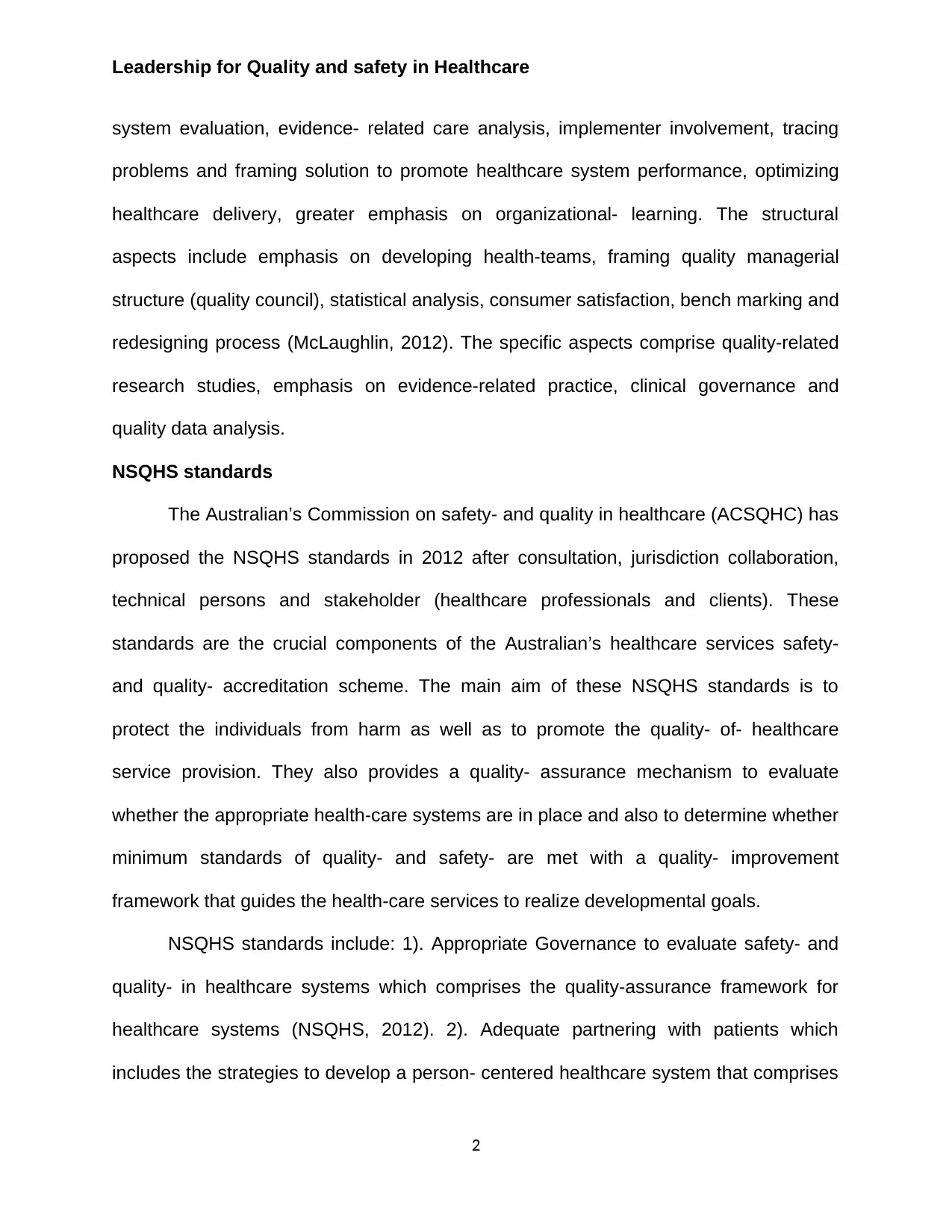
Leadership for Quality and safety in Healthcare
system evaluation, evidence- related care analysis, implementer involvement, tracing
problems and framing solution to promote healthcare system performance, optimizing
healthcare delivery, greater emphasis on organizational- learning. The structural
aspects include emphasis on developing health-teams, framing quality managerial
structure (quality council), statistical analysis, consumer satisfaction, bench marking and
redesigning process (McLaughlin, 2012). The specific aspects comprise quality-related
research studies, emphasis on evidence-related practice, clinical governance and
quality data analysis.
NSQHS standards
The Australian’s Commission on safety- and quality in healthcare (ACSQHC) has
proposed the NSQHS standards in 2012 after consultation, jurisdiction collaboration,
technical persons and stakeholder (healthcare professionals and clients). These
standards are the crucial components of the Australian’s healthcare services safety-
and quality- accreditation scheme. The main aim of these NSQHS standards is to
protect the individuals from harm as well as to promote the quality- of- healthcare
service provision. They also provides a quality- assurance mechanism to evaluate
whether the appropriate health-care systems are in place and also to determine whether
minimum standards of quality- and safety- are met with a quality- improvement
framework that guides the health-care services to realize developmental goals.
NSQHS standards include: 1). Appropriate Governance to evaluate safety- and
quality- in healthcare systems which comprises the quality-assurance framework for
healthcare systems (NSQHS, 2012). 2). Adequate partnering with patients which
includes the strategies to develop a person- centered healthcare system that comprises
2
system evaluation, evidence- related care analysis, implementer involvement, tracing
problems and framing solution to promote healthcare system performance, optimizing
healthcare delivery, greater emphasis on organizational- learning. The structural
aspects include emphasis on developing health-teams, framing quality managerial
structure (quality council), statistical analysis, consumer satisfaction, bench marking and
redesigning process (McLaughlin, 2012). The specific aspects comprise quality-related
research studies, emphasis on evidence-related practice, clinical governance and
quality data analysis.
NSQHS standards
The Australian’s Commission on safety- and quality in healthcare (ACSQHC) has
proposed the NSQHS standards in 2012 after consultation, jurisdiction collaboration,
technical persons and stakeholder (healthcare professionals and clients). These
standards are the crucial components of the Australian’s healthcare services safety-
and quality- accreditation scheme. The main aim of these NSQHS standards is to
protect the individuals from harm as well as to promote the quality- of- healthcare
service provision. They also provides a quality- assurance mechanism to evaluate
whether the appropriate health-care systems are in place and also to determine whether
minimum standards of quality- and safety- are met with a quality- improvement
framework that guides the health-care services to realize developmental goals.
NSQHS standards include: 1). Appropriate Governance to evaluate safety- and
quality- in healthcare systems which comprises the quality-assurance framework for
healthcare systems (NSQHS, 2012). 2). Adequate partnering with patients which
includes the strategies to develop a person- centered healthcare system that comprises
2
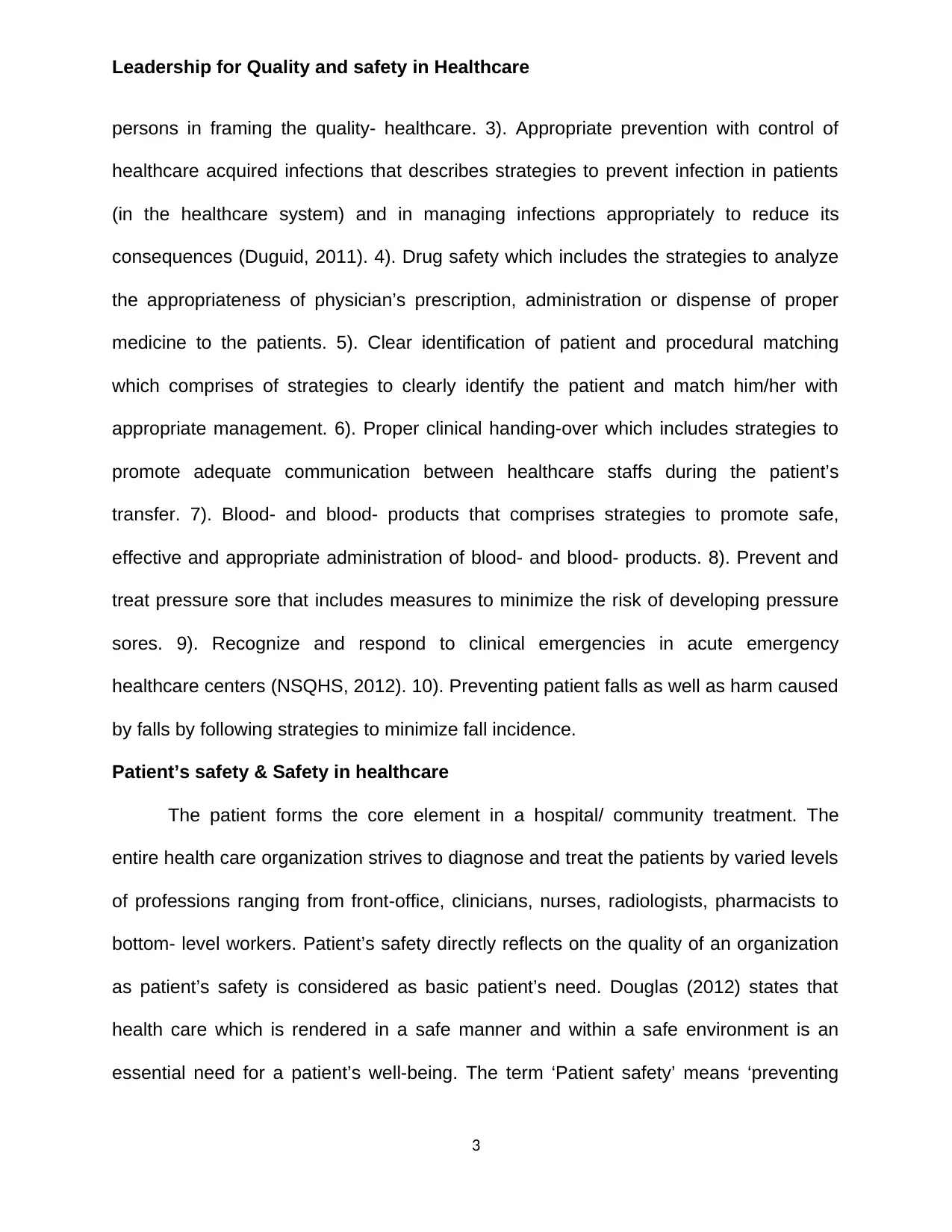
Leadership for Quality and safety in Healthcare
persons in framing the quality- healthcare. 3). Appropriate prevention with control of
healthcare acquired infections that describes strategies to prevent infection in patients
(in the healthcare system) and in managing infections appropriately to reduce its
consequences (Duguid, 2011). 4). Drug safety which includes the strategies to analyze
the appropriateness of physician’s prescription, administration or dispense of proper
medicine to the patients. 5). Clear identification of patient and procedural matching
which comprises of strategies to clearly identify the patient and match him/her with
appropriate management. 6). Proper clinical handing-over which includes strategies to
promote adequate communication between healthcare staffs during the patient’s
transfer. 7). Blood- and blood- products that comprises strategies to promote safe,
effective and appropriate administration of blood- and blood- products. 8). Prevent and
treat pressure sore that includes measures to minimize the risk of developing pressure
sores. 9). Recognize and respond to clinical emergencies in acute emergency
healthcare centers (NSQHS, 2012). 10). Preventing patient falls as well as harm caused
by falls by following strategies to minimize fall incidence.
Patient’s safety & Safety in healthcare
The patient forms the core element in a hospital/ community treatment. The
entire health care organization strives to diagnose and treat the patients by varied levels
of professions ranging from front-office, clinicians, nurses, radiologists, pharmacists to
bottom- level workers. Patient’s safety directly reflects on the quality of an organization
as patient’s safety is considered as basic patient’s need. Douglas (2012) states that
health care which is rendered in a safe manner and within a safe environment is an
essential need for a patient’s well-being. The term ‘Patient safety’ means ‘preventing
3
persons in framing the quality- healthcare. 3). Appropriate prevention with control of
healthcare acquired infections that describes strategies to prevent infection in patients
(in the healthcare system) and in managing infections appropriately to reduce its
consequences (Duguid, 2011). 4). Drug safety which includes the strategies to analyze
the appropriateness of physician’s prescription, administration or dispense of proper
medicine to the patients. 5). Clear identification of patient and procedural matching
which comprises of strategies to clearly identify the patient and match him/her with
appropriate management. 6). Proper clinical handing-over which includes strategies to
promote adequate communication between healthcare staffs during the patient’s
transfer. 7). Blood- and blood- products that comprises strategies to promote safe,
effective and appropriate administration of blood- and blood- products. 8). Prevent and
treat pressure sore that includes measures to minimize the risk of developing pressure
sores. 9). Recognize and respond to clinical emergencies in acute emergency
healthcare centers (NSQHS, 2012). 10). Preventing patient falls as well as harm caused
by falls by following strategies to minimize fall incidence.
Patient’s safety & Safety in healthcare
The patient forms the core element in a hospital/ community treatment. The
entire health care organization strives to diagnose and treat the patients by varied levels
of professions ranging from front-office, clinicians, nurses, radiologists, pharmacists to
bottom- level workers. Patient’s safety directly reflects on the quality of an organization
as patient’s safety is considered as basic patient’s need. Douglas (2012) states that
health care which is rendered in a safe manner and within a safe environment is an
essential need for a patient’s well-being. The term ‘Patient safety’ means ‘preventing
3
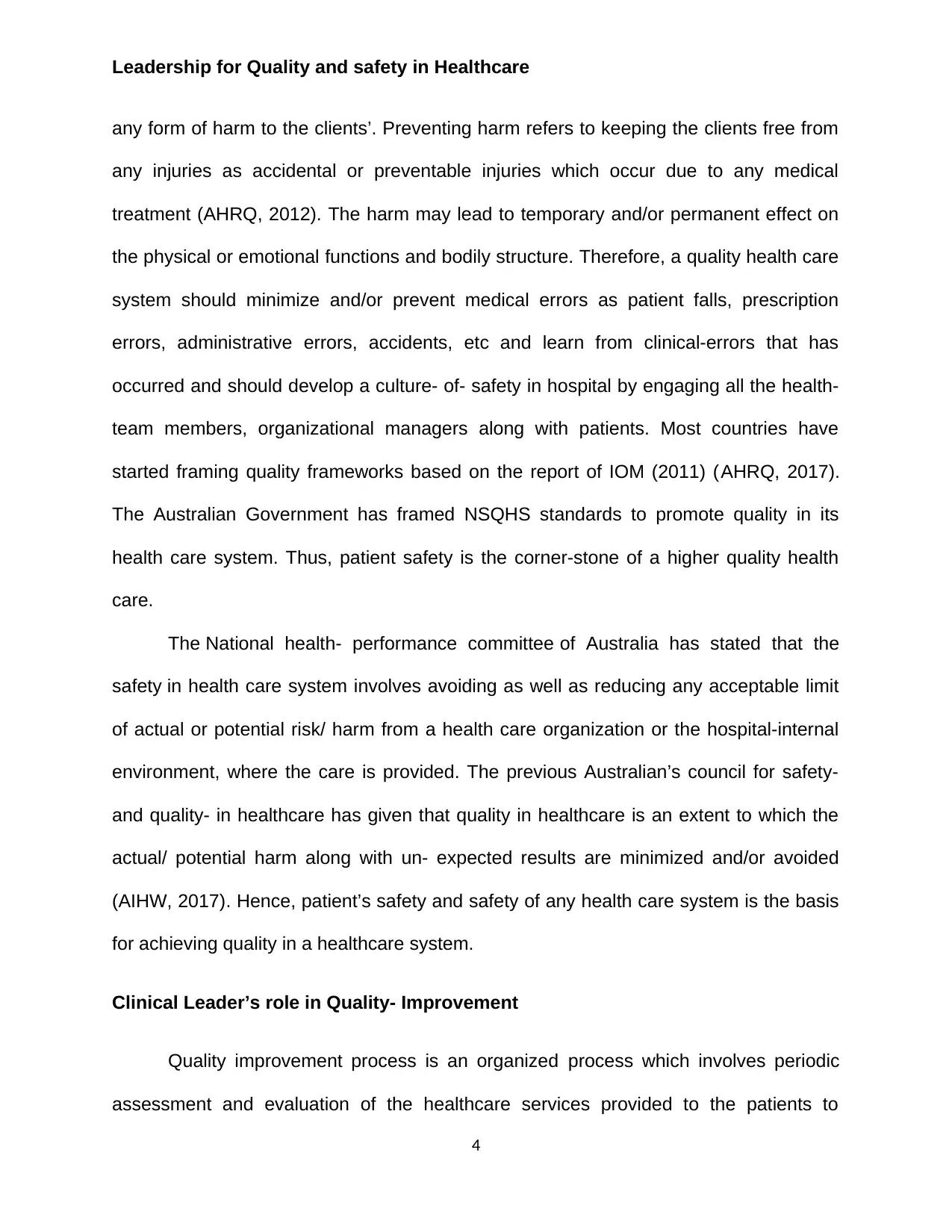
Leadership for Quality and safety in Healthcare
any form of harm to the clients’. Preventing harm refers to keeping the clients free from
any injuries as accidental or preventable injuries which occur due to any medical
treatment (AHRQ, 2012). The harm may lead to temporary and/or permanent effect on
the physical or emotional functions and bodily structure. Therefore, a quality health care
system should minimize and/or prevent medical errors as patient falls, prescription
errors, administrative errors, accidents, etc and learn from clinical-errors that has
occurred and should develop a culture- of- safety in hospital by engaging all the health-
team members, organizational managers along with patients. Most countries have
started framing quality frameworks based on the report of IOM (2011) (AHRQ, 2017).
The Australian Government has framed NSQHS standards to promote quality in its
health care system. Thus, patient safety is the corner-stone of a higher quality health
care.
The National health- performance committee of Australia has stated that the
safety in health care system involves avoiding as well as reducing any acceptable limit
of actual or potential risk/ harm from a health care organization or the hospital-internal
environment, where the care is provided. The previous Australian’s council for safety-
and quality- in healthcare has given that quality in healthcare is an extent to which the
actual/ potential harm along with un- expected results are minimized and/or avoided
(AIHW, 2017). Hence, patient’s safety and safety of any health care system is the basis
for achieving quality in a healthcare system.
Clinical Leader’s role in Quality- Improvement
Quality improvement process is an organized process which involves periodic
assessment and evaluation of the healthcare services provided to the patients to
4
any form of harm to the clients’. Preventing harm refers to keeping the clients free from
any injuries as accidental or preventable injuries which occur due to any medical
treatment (AHRQ, 2012). The harm may lead to temporary and/or permanent effect on
the physical or emotional functions and bodily structure. Therefore, a quality health care
system should minimize and/or prevent medical errors as patient falls, prescription
errors, administrative errors, accidents, etc and learn from clinical-errors that has
occurred and should develop a culture- of- safety in hospital by engaging all the health-
team members, organizational managers along with patients. Most countries have
started framing quality frameworks based on the report of IOM (2011) (AHRQ, 2017).
The Australian Government has framed NSQHS standards to promote quality in its
health care system. Thus, patient safety is the corner-stone of a higher quality health
care.
The National health- performance committee of Australia has stated that the
safety in health care system involves avoiding as well as reducing any acceptable limit
of actual or potential risk/ harm from a health care organization or the hospital-internal
environment, where the care is provided. The previous Australian’s council for safety-
and quality- in healthcare has given that quality in healthcare is an extent to which the
actual/ potential harm along with un- expected results are minimized and/or avoided
(AIHW, 2017). Hence, patient’s safety and safety of any health care system is the basis
for achieving quality in a healthcare system.
Clinical Leader’s role in Quality- Improvement
Quality improvement process is an organized process which involves periodic
assessment and evaluation of the healthcare services provided to the patients to
4
Secure Best Marks with AI Grader
Need help grading? Try our AI Grader for instant feedback on your assignments.
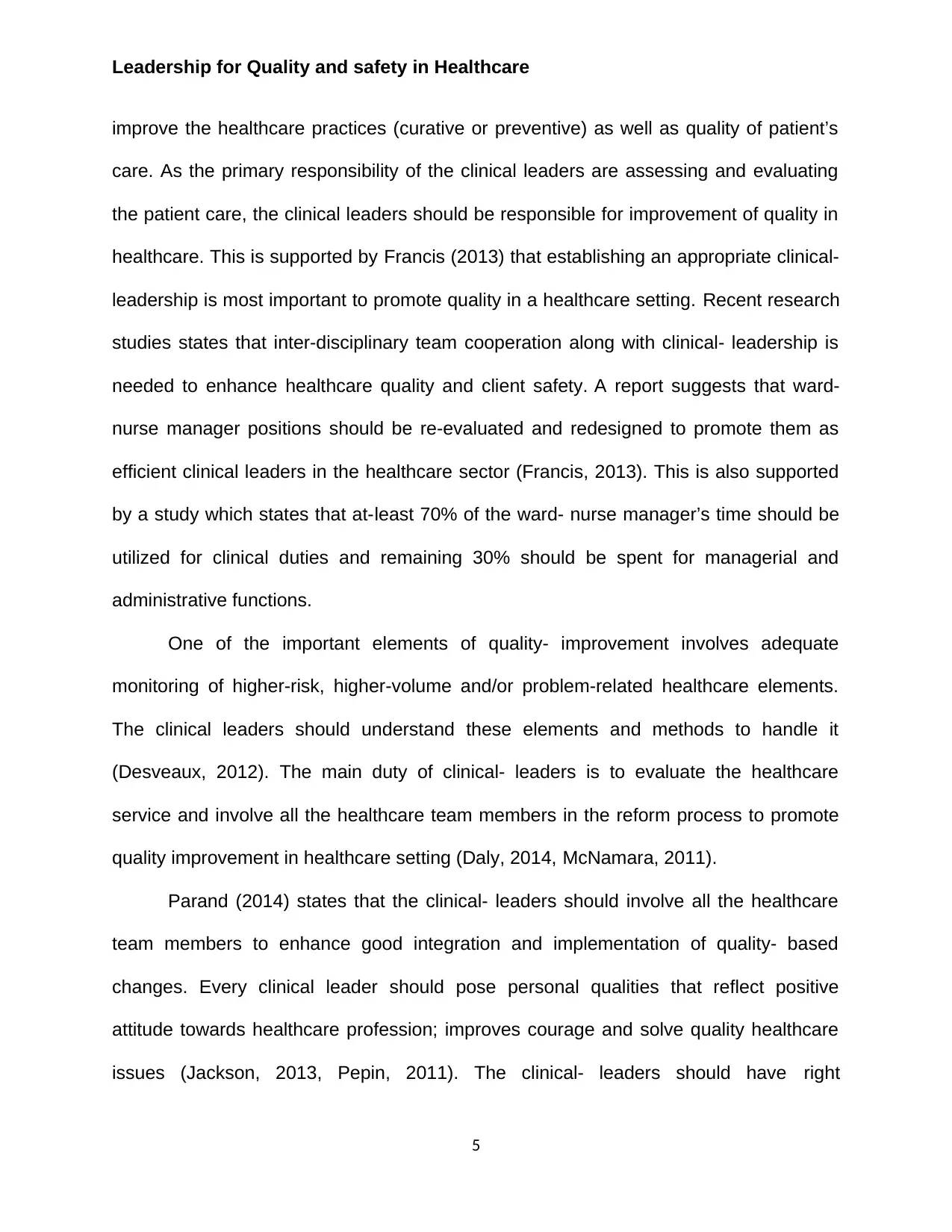
Leadership for Quality and safety in Healthcare
improve the healthcare practices (curative or preventive) as well as quality of patient’s
care. As the primary responsibility of the clinical leaders are assessing and evaluating
the patient care, the clinical leaders should be responsible for improvement of quality in
healthcare. This is supported by Francis (2013) that establishing an appropriate clinical-
leadership is most important to promote quality in a healthcare setting. Recent research
studies states that inter-disciplinary team cooperation along with clinical- leadership is
needed to enhance healthcare quality and client safety. A report suggests that ward-
nurse manager positions should be re-evaluated and redesigned to promote them as
efficient clinical leaders in the healthcare sector (Francis, 2013). This is also supported
by a study which states that at-least 70% of the ward- nurse manager’s time should be
utilized for clinical duties and remaining 30% should be spent for managerial and
administrative functions.
One of the important elements of quality- improvement involves adequate
monitoring of higher-risk, higher-volume and/or problem-related healthcare elements.
The clinical leaders should understand these elements and methods to handle it
(Desveaux, 2012). The main duty of clinical- leaders is to evaluate the healthcare
service and involve all the healthcare team members in the reform process to promote
quality improvement in healthcare setting (Daly, 2014, McNamara, 2011).
Parand (2014) states that the clinical- leaders should involve all the healthcare
team members to enhance good integration and implementation of quality- based
changes. Every clinical leader should pose personal qualities that reflect positive
attitude towards healthcare profession; improves courage and solve quality healthcare
issues (Jackson, 2013, Pepin, 2011). The clinical- leaders should have right
5
improve the healthcare practices (curative or preventive) as well as quality of patient’s
care. As the primary responsibility of the clinical leaders are assessing and evaluating
the patient care, the clinical leaders should be responsible for improvement of quality in
healthcare. This is supported by Francis (2013) that establishing an appropriate clinical-
leadership is most important to promote quality in a healthcare setting. Recent research
studies states that inter-disciplinary team cooperation along with clinical- leadership is
needed to enhance healthcare quality and client safety. A report suggests that ward-
nurse manager positions should be re-evaluated and redesigned to promote them as
efficient clinical leaders in the healthcare sector (Francis, 2013). This is also supported
by a study which states that at-least 70% of the ward- nurse manager’s time should be
utilized for clinical duties and remaining 30% should be spent for managerial and
administrative functions.
One of the important elements of quality- improvement involves adequate
monitoring of higher-risk, higher-volume and/or problem-related healthcare elements.
The clinical leaders should understand these elements and methods to handle it
(Desveaux, 2012). The main duty of clinical- leaders is to evaluate the healthcare
service and involve all the healthcare team members in the reform process to promote
quality improvement in healthcare setting (Daly, 2014, McNamara, 2011).
Parand (2014) states that the clinical- leaders should involve all the healthcare
team members to enhance good integration and implementation of quality- based
changes. Every clinical leader should pose personal qualities that reflect positive
attitude towards healthcare profession; improves courage and solve quality healthcare
issues (Jackson, 2013, Pepin, 2011). The clinical- leaders should have right
5
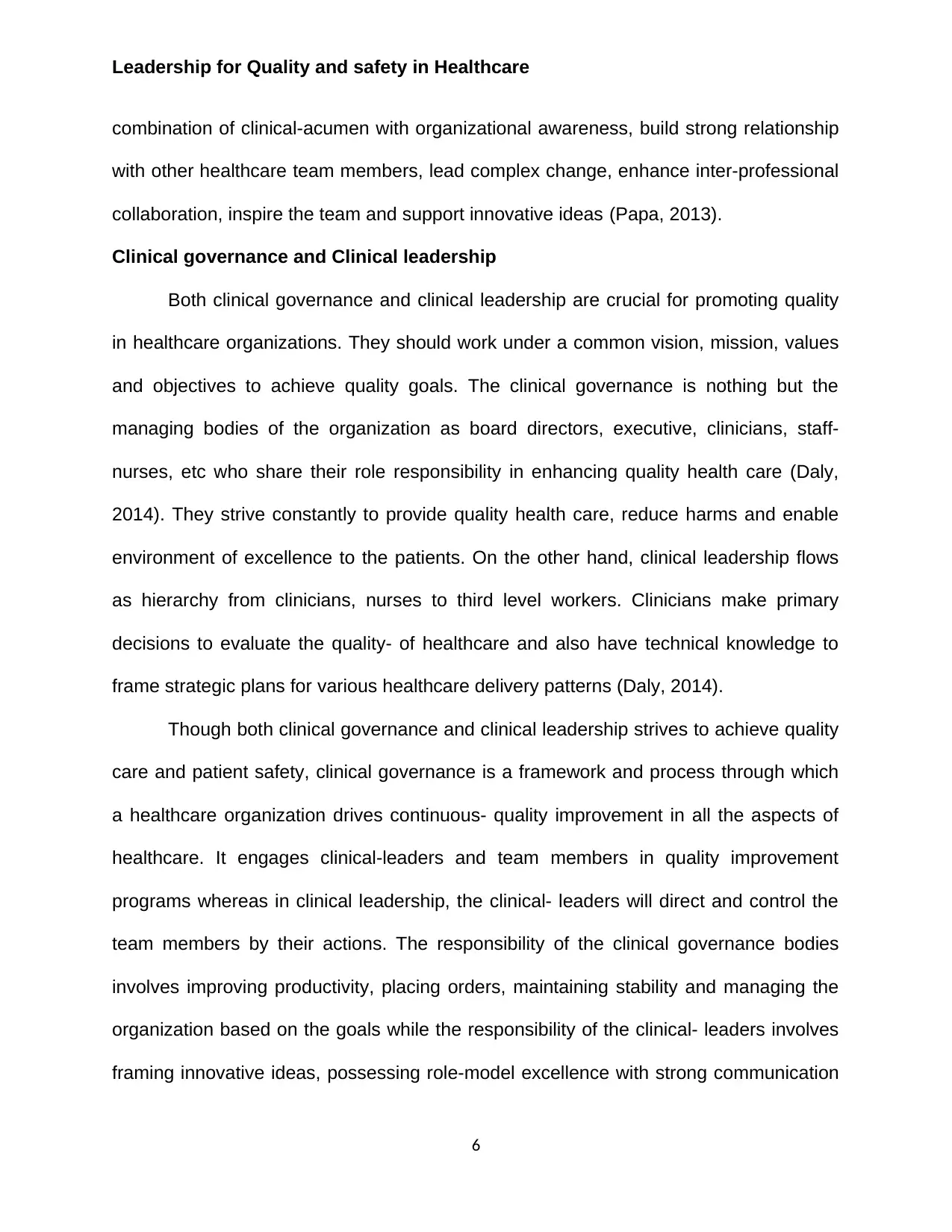
Leadership for Quality and safety in Healthcare
combination of clinical-acumen with organizational awareness, build strong relationship
with other healthcare team members, lead complex change, enhance inter-professional
collaboration, inspire the team and support innovative ideas (Papa, 2013).
Clinical governance and Clinical leadership
Both clinical governance and clinical leadership are crucial for promoting quality
in healthcare organizations. They should work under a common vision, mission, values
and objectives to achieve quality goals. The clinical governance is nothing but the
managing bodies of the organization as board directors, executive, clinicians, staff-
nurses, etc who share their role responsibility in enhancing quality health care (Daly,
2014). They strive constantly to provide quality health care, reduce harms and enable
environment of excellence to the patients. On the other hand, clinical leadership flows
as hierarchy from clinicians, nurses to third level workers. Clinicians make primary
decisions to evaluate the quality- of healthcare and also have technical knowledge to
frame strategic plans for various healthcare delivery patterns (Daly, 2014).
Though both clinical governance and clinical leadership strives to achieve quality
care and patient safety, clinical governance is a framework and process through which
a healthcare organization drives continuous- quality improvement in all the aspects of
healthcare. It engages clinical-leaders and team members in quality improvement
programs whereas in clinical leadership, the clinical- leaders will direct and control the
team members by their actions. The responsibility of the clinical governance bodies
involves improving productivity, placing orders, maintaining stability and managing the
organization based on the goals while the responsibility of the clinical- leaders involves
framing innovative ideas, possessing role-model excellence with strong communication
6
combination of clinical-acumen with organizational awareness, build strong relationship
with other healthcare team members, lead complex change, enhance inter-professional
collaboration, inspire the team and support innovative ideas (Papa, 2013).
Clinical governance and Clinical leadership
Both clinical governance and clinical leadership are crucial for promoting quality
in healthcare organizations. They should work under a common vision, mission, values
and objectives to achieve quality goals. The clinical governance is nothing but the
managing bodies of the organization as board directors, executive, clinicians, staff-
nurses, etc who share their role responsibility in enhancing quality health care (Daly,
2014). They strive constantly to provide quality health care, reduce harms and enable
environment of excellence to the patients. On the other hand, clinical leadership flows
as hierarchy from clinicians, nurses to third level workers. Clinicians make primary
decisions to evaluate the quality- of healthcare and also have technical knowledge to
frame strategic plans for various healthcare delivery patterns (Daly, 2014).
Though both clinical governance and clinical leadership strives to achieve quality
care and patient safety, clinical governance is a framework and process through which
a healthcare organization drives continuous- quality improvement in all the aspects of
healthcare. It engages clinical-leaders and team members in quality improvement
programs whereas in clinical leadership, the clinical- leaders will direct and control the
team members by their actions. The responsibility of the clinical governance bodies
involves improving productivity, placing orders, maintaining stability and managing the
organization based on the goals while the responsibility of the clinical- leaders involves
framing innovative ideas, possessing role-model excellence with strong communication
6
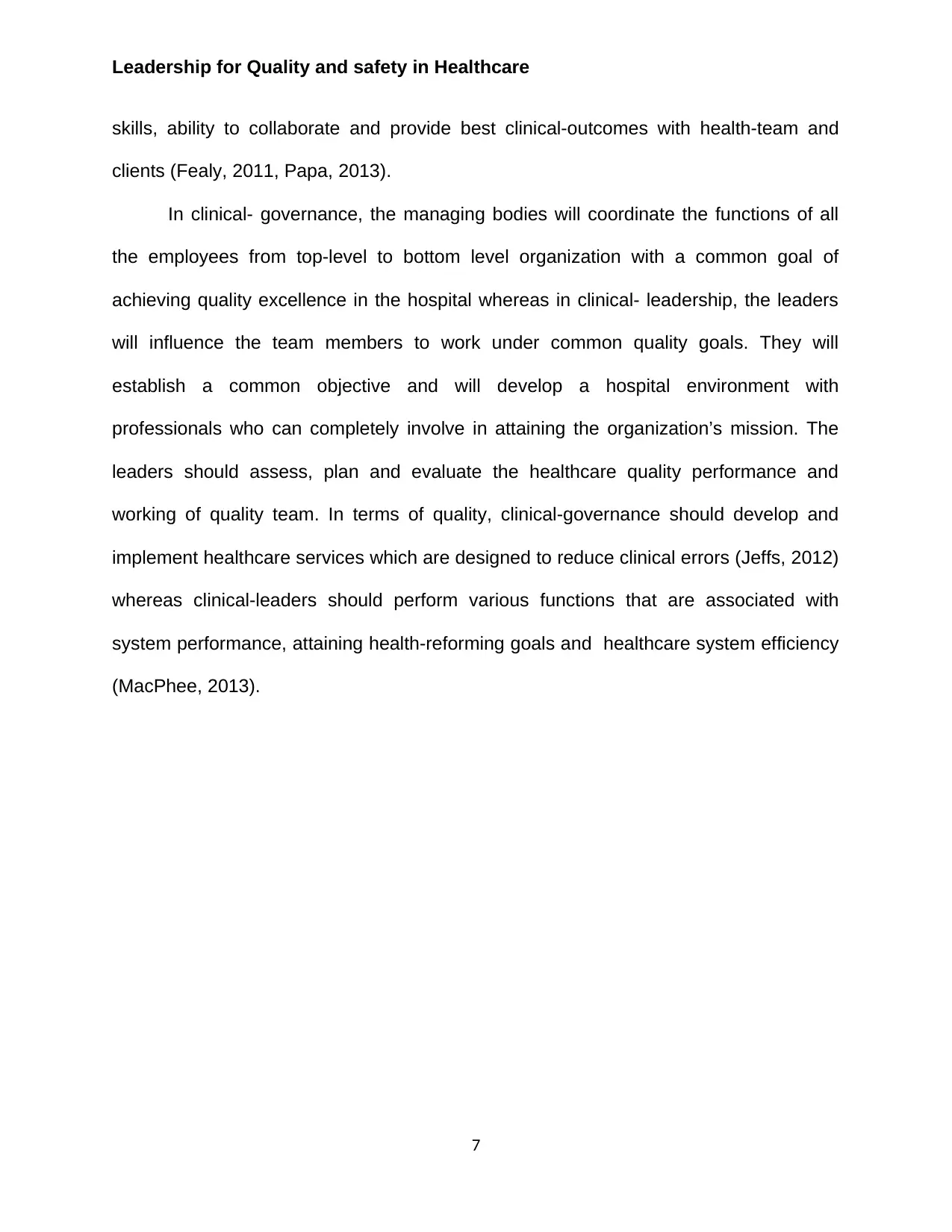
Leadership for Quality and safety in Healthcare
skills, ability to collaborate and provide best clinical-outcomes with health-team and
clients (Fealy, 2011, Papa, 2013).
In clinical- governance, the managing bodies will coordinate the functions of all
the employees from top-level to bottom level organization with a common goal of
achieving quality excellence in the hospital whereas in clinical- leadership, the leaders
will influence the team members to work under common quality goals. They will
establish a common objective and will develop a hospital environment with
professionals who can completely involve in attaining the organization’s mission. The
leaders should assess, plan and evaluate the healthcare quality performance and
working of quality team. In terms of quality, clinical-governance should develop and
implement healthcare services which are designed to reduce clinical errors (Jeffs, 2012)
whereas clinical-leaders should perform various functions that are associated with
system performance, attaining health-reforming goals and healthcare system efficiency
(MacPhee, 2013).
7
skills, ability to collaborate and provide best clinical-outcomes with health-team and
clients (Fealy, 2011, Papa, 2013).
In clinical- governance, the managing bodies will coordinate the functions of all
the employees from top-level to bottom level organization with a common goal of
achieving quality excellence in the hospital whereas in clinical- leadership, the leaders
will influence the team members to work under common quality goals. They will
establish a common objective and will develop a hospital environment with
professionals who can completely involve in attaining the organization’s mission. The
leaders should assess, plan and evaluate the healthcare quality performance and
working of quality team. In terms of quality, clinical-governance should develop and
implement healthcare services which are designed to reduce clinical errors (Jeffs, 2012)
whereas clinical-leaders should perform various functions that are associated with
system performance, attaining health-reforming goals and healthcare system efficiency
(MacPhee, 2013).
7
Paraphrase This Document
Need a fresh take? Get an instant paraphrase of this document with our AI Paraphraser
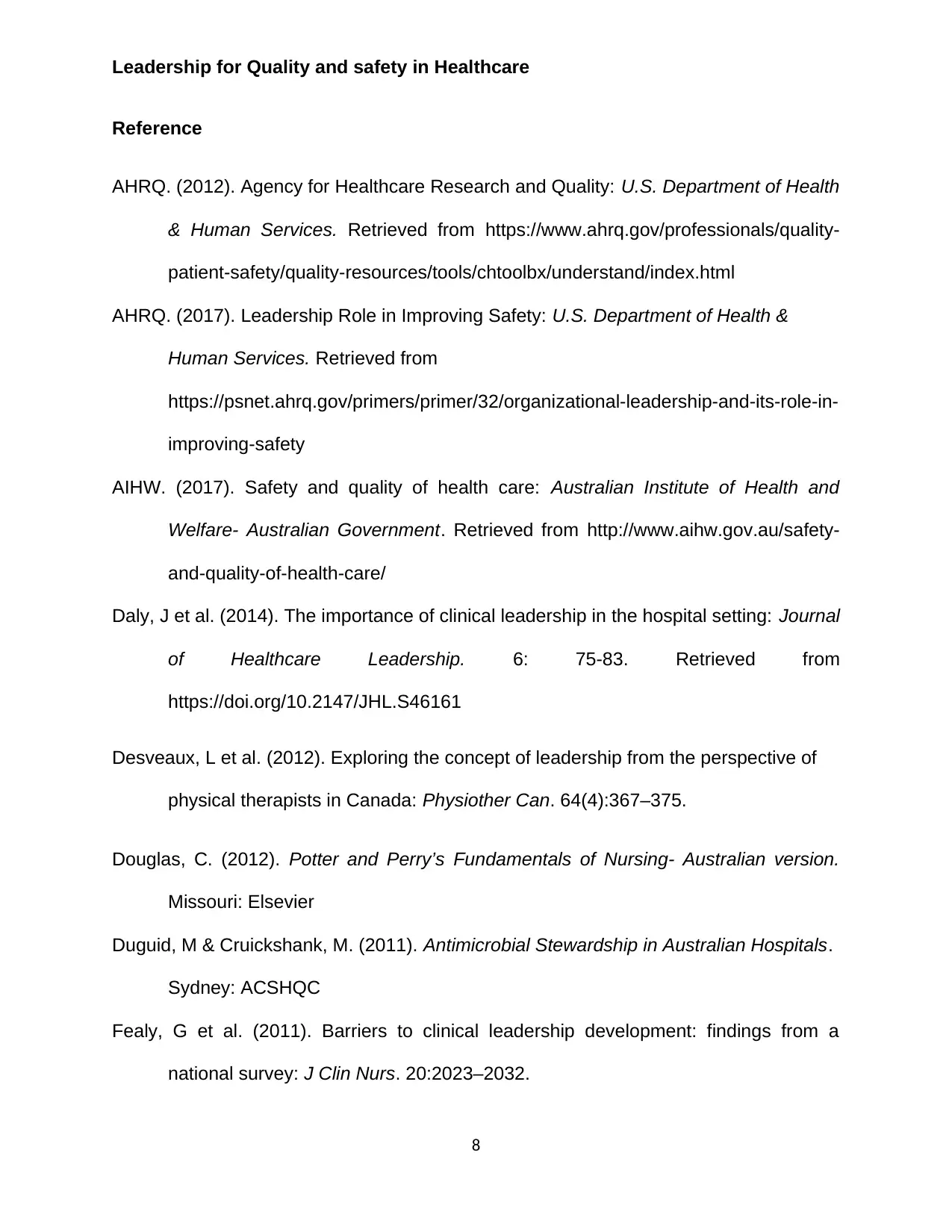
Leadership for Quality and safety in Healthcare
Reference
AHRQ. (2012). Agency for Healthcare Research and Quality: U.S. Department of Health
& Human Services. Retrieved from https://www.ahrq.gov/professionals/quality-
patient-safety/quality-resources/tools/chtoolbx/understand/index.html
AHRQ. (2017). Leadership Role in Improving Safety: U.S. Department of Health &
Human Services. Retrieved from
https://psnet.ahrq.gov/primers/primer/32/organizational-leadership-and-its-role-in-
improving-safety
AIHW. (2017). Safety and quality of health care: Australian Institute of Health and
Welfare- Australian Government. Retrieved from http://www.aihw.gov.au/safety-
and-quality-of-health-care/
Daly, J et al. (2014). The importance of clinical leadership in the hospital setting: Journal
of Healthcare Leadership. 6: 75-83. Retrieved from
https://doi.org/10.2147/JHL.S46161
Desveaux, L et al. (2012). Exploring the concept of leadership from the perspective of
physical therapists in Canada: Physiother Can. 64(4):367–375.
Douglas, C. (2012). Potter and Perry’s Fundamentals of Nursing- Australian version.
Missouri: Elsevier
Duguid, M & Cruickshank, M. (2011). Antimicrobial Stewardship in Australian Hospitals.
Sydney: ACSHQC
Fealy, G et al. (2011). Barriers to clinical leadership development: findings from a
national survey: J Clin Nurs. 20:2023–2032.
8
Reference
AHRQ. (2012). Agency for Healthcare Research and Quality: U.S. Department of Health
& Human Services. Retrieved from https://www.ahrq.gov/professionals/quality-
patient-safety/quality-resources/tools/chtoolbx/understand/index.html
AHRQ. (2017). Leadership Role in Improving Safety: U.S. Department of Health &
Human Services. Retrieved from
https://psnet.ahrq.gov/primers/primer/32/organizational-leadership-and-its-role-in-
improving-safety
AIHW. (2017). Safety and quality of health care: Australian Institute of Health and
Welfare- Australian Government. Retrieved from http://www.aihw.gov.au/safety-
and-quality-of-health-care/
Daly, J et al. (2014). The importance of clinical leadership in the hospital setting: Journal
of Healthcare Leadership. 6: 75-83. Retrieved from
https://doi.org/10.2147/JHL.S46161
Desveaux, L et al. (2012). Exploring the concept of leadership from the perspective of
physical therapists in Canada: Physiother Can. 64(4):367–375.
Douglas, C. (2012). Potter and Perry’s Fundamentals of Nursing- Australian version.
Missouri: Elsevier
Duguid, M & Cruickshank, M. (2011). Antimicrobial Stewardship in Australian Hospitals.
Sydney: ACSHQC
Fealy, G et al. (2011). Barriers to clinical leadership development: findings from a
national survey: J Clin Nurs. 20:2023–2032.
8
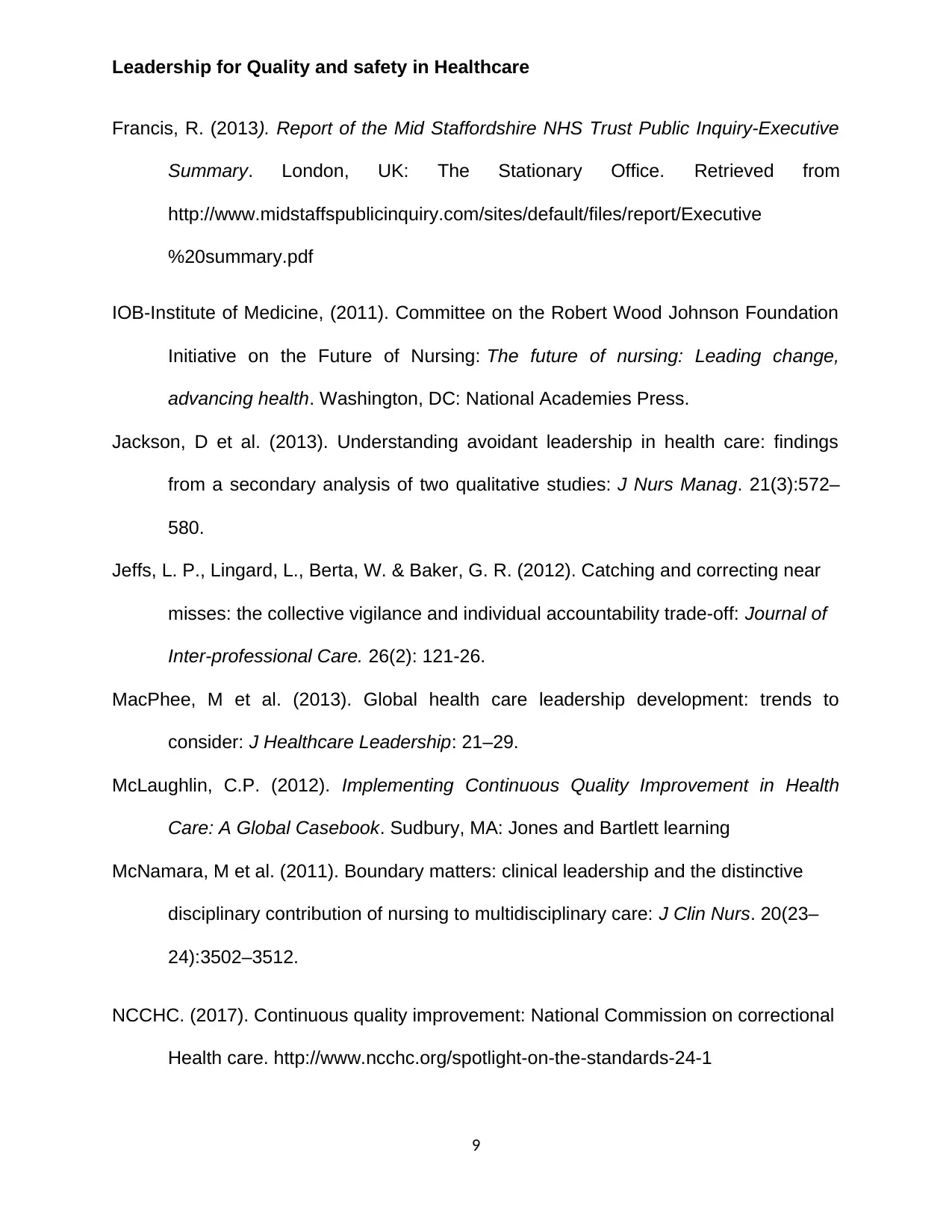
Leadership for Quality and safety in Healthcare
Francis, R. (2013). Report of the Mid Staffordshire NHS Trust Public Inquiry-Executive
Summary. London, UK: The Stationary Office. Retrieved from
http://www.midstaffspublicinquiry.com/sites/default/files/report/Executive
%20summary.pdf
IOB-Institute of Medicine, (2011). Committee on the Robert Wood Johnson Foundation
Initiative on the Future of Nursing: The future of nursing: Leading change,
advancing health. Washington, DC: National Academies Press.
Jackson, D et al. (2013). Understanding avoidant leadership in health care: findings
from a secondary analysis of two qualitative studies: J Nurs Manag. 21(3):572–
580.
Jeffs, L. P., Lingard, L., Berta, W. & Baker, G. R. (2012). Catching and correcting near
misses: the collective vigilance and individual accountability trade-off: Journal of
Inter-professional Care. 26(2): 121-26.
MacPhee, M et al. (2013). Global health care leadership development: trends to
consider: J Healthcare Leadership: 21–29.
McLaughlin, C.P. (2012). Implementing Continuous Quality Improvement in Health
Care: A Global Casebook. Sudbury, MA: Jones and Bartlett learning
McNamara, M et al. (2011). Boundary matters: clinical leadership and the distinctive
disciplinary contribution of nursing to multidisciplinary care: J Clin Nurs. 20(23–
24):3502–3512.
NCCHC. (2017). Continuous quality improvement: National Commission on correctional
Health care. http://www.ncchc.org/spotlight-on-the-standards-24-1
9
Francis, R. (2013). Report of the Mid Staffordshire NHS Trust Public Inquiry-Executive
Summary. London, UK: The Stationary Office. Retrieved from
http://www.midstaffspublicinquiry.com/sites/default/files/report/Executive
%20summary.pdf
IOB-Institute of Medicine, (2011). Committee on the Robert Wood Johnson Foundation
Initiative on the Future of Nursing: The future of nursing: Leading change,
advancing health. Washington, DC: National Academies Press.
Jackson, D et al. (2013). Understanding avoidant leadership in health care: findings
from a secondary analysis of two qualitative studies: J Nurs Manag. 21(3):572–
580.
Jeffs, L. P., Lingard, L., Berta, W. & Baker, G. R. (2012). Catching and correcting near
misses: the collective vigilance and individual accountability trade-off: Journal of
Inter-professional Care. 26(2): 121-26.
MacPhee, M et al. (2013). Global health care leadership development: trends to
consider: J Healthcare Leadership: 21–29.
McLaughlin, C.P. (2012). Implementing Continuous Quality Improvement in Health
Care: A Global Casebook. Sudbury, MA: Jones and Bartlett learning
McNamara, M et al. (2011). Boundary matters: clinical leadership and the distinctive
disciplinary contribution of nursing to multidisciplinary care: J Clin Nurs. 20(23–
24):3502–3512.
NCCHC. (2017). Continuous quality improvement: National Commission on correctional
Health care. http://www.ncchc.org/spotlight-on-the-standards-24-1
9
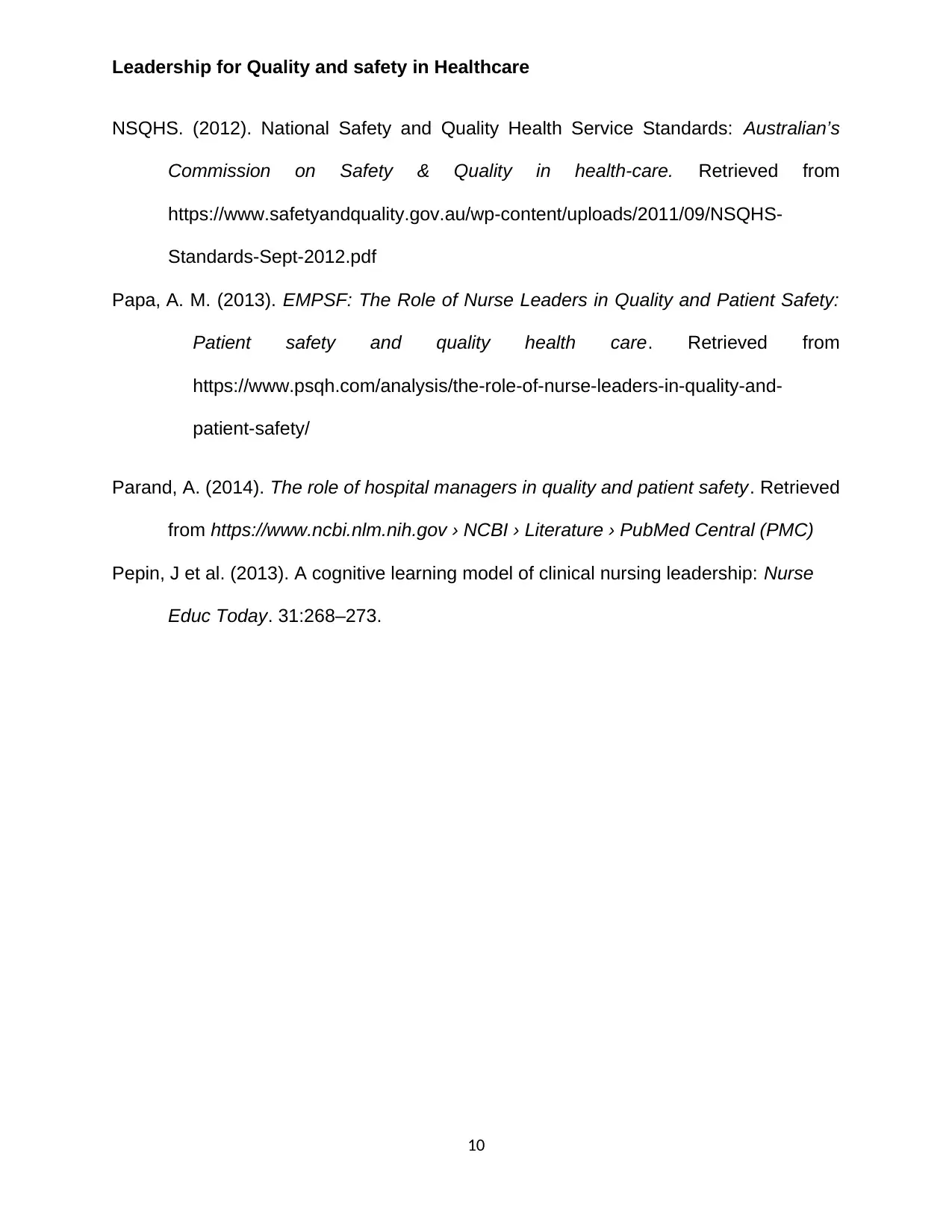
Leadership for Quality and safety in Healthcare
NSQHS. (2012). National Safety and Quality Health Service Standards: Australian’s
Commission on Safety & Quality in health-care. Retrieved from
https://www.safetyandquality.gov.au/wp-content/uploads/2011/09/NSQHS-
Standards-Sept-2012.pdf
Papa, A. M. (2013). EMPSF: The Role of Nurse Leaders in Quality and Patient Safety:
Patient safety and quality health care. Retrieved from
https://www.psqh.com/analysis/the-role-of-nurse-leaders-in-quality-and-
patient-safety/
Parand, A. (2014). The role of hospital managers in quality and patient safety. Retrieved
from https://www.ncbi.nlm.nih.gov › NCBI › Literature › PubMed Central (PMC)
Pepin, J et al. (2013). A cognitive learning model of clinical nursing leadership: Nurse
Educ Today. 31:268–273.
10
NSQHS. (2012). National Safety and Quality Health Service Standards: Australian’s
Commission on Safety & Quality in health-care. Retrieved from
https://www.safetyandquality.gov.au/wp-content/uploads/2011/09/NSQHS-
Standards-Sept-2012.pdf
Papa, A. M. (2013). EMPSF: The Role of Nurse Leaders in Quality and Patient Safety:
Patient safety and quality health care. Retrieved from
https://www.psqh.com/analysis/the-role-of-nurse-leaders-in-quality-and-
patient-safety/
Parand, A. (2014). The role of hospital managers in quality and patient safety. Retrieved
from https://www.ncbi.nlm.nih.gov › NCBI › Literature › PubMed Central (PMC)
Pepin, J et al. (2013). A cognitive learning model of clinical nursing leadership: Nurse
Educ Today. 31:268–273.
10
1 out of 10
Related Documents
Your All-in-One AI-Powered Toolkit for Academic Success.
+13062052269
info@desklib.com
Available 24*7 on WhatsApp / Email
![[object Object]](/_next/static/media/star-bottom.7253800d.svg)
Unlock your academic potential
© 2024 | Zucol Services PVT LTD | All rights reserved.




